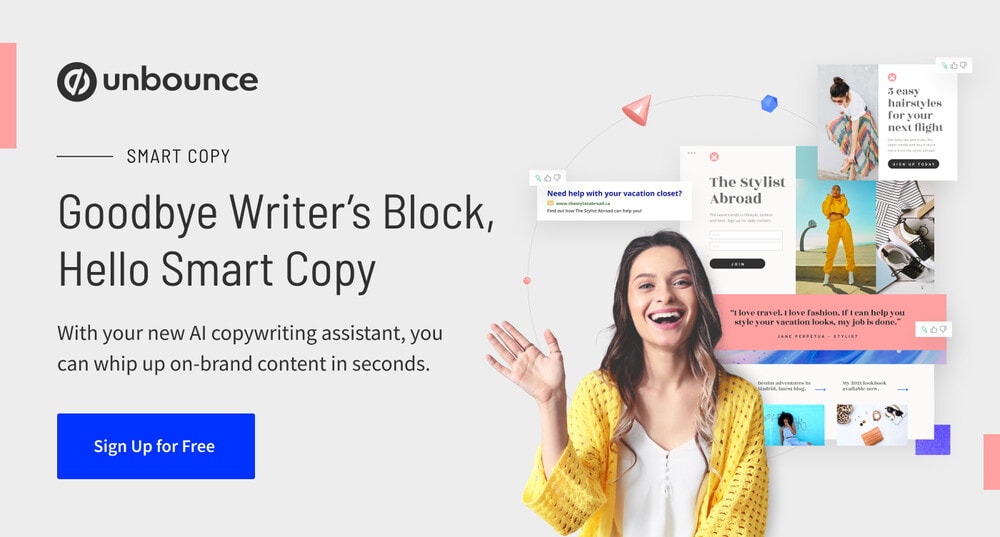An AI copywriting tool able to generate content at the push of a button? Copywriters the world over shudder at the mere thought of it. A machine that writes emails, headings, landing pages, and more?! Madness!
But as this copywriter—who’s very much human—will tell you, there’s nothing to fear.
Imagine a world where you don’t have to agonize over every word, but rather plug your requirements into a machine—and presto!—the work has been done. It means you can spend your time editing, refining, and optimizing copy for various personas and channels, not brooding over draft 4.5 trying to make it all make sense.
With AI, meet your new copywriting assistant that takes care of tedious writing tasks so that you can focus on what really matters: getting campaigns to convert.
 Typing like you’re a minute away from a deadline every day? Yeah, an AI copywriter can help with that.
Typing like you’re a minute away from a deadline every day? Yeah, an AI copywriter can help with that.
So, how can you use AI copywriting tools in your marketing efforts? Let’s start with everything you need to know and explore how you can incorporate AI into your marketing stack—without alienating your human creators:
(You can also fast-track straight to your burning questions here:  )
)
2. Will AI Replace Copywriters?
3. How to Use AI Copywriting Tools
4. What is the Best AI Copywriter?
1. What is AI Copywriting?
AI copywriting is content generated by machine-learning software. It does this by training an algorithm to crunch millions of web pages looking for patterns. It then uses that knowledge to generate new content on a set topic.
Artificial intelligence tools have become remarkably clever in their ability to mimic and understand language—even slang. Headlines, emails, ads, meta tags, even product descriptions—the possibilities are endless. You simply add your parameters and let the machine do the rest. Talk about time-saving not having to tackle content word by word, right?
Chris Frantz, Vice President of Smart Copy (formerly Snazzy.AI)—an AI copywriting tool part of the Unbounce family—explains:
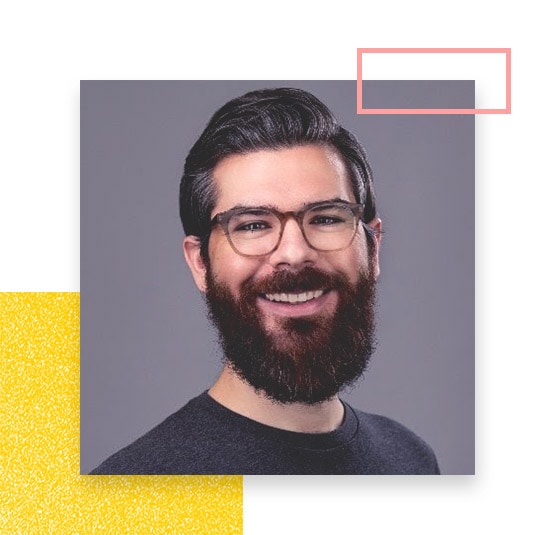
Much of a marketer’s job is writing. Sometimes, writer’s block occurs, making it difficult to come up with the next sentence or an additional revision. That’s where AI copywriting comes in. It supplements your writing stack and process with a third-party smart assistant, and can help bolster your existing copywriting skills and fill in the blanks where you might get stuck otherwise. — Chris Frantz, VP, Smart Copy (Snazzy.AI)
Snazzy AI is now Smart Copy, part of the Unbounce Conversion Intelligence Platform. We’ve brought AI-powered copywriting to take the pain out of copywriting and help you create those optimized marketing campaigns way faster. Try Smart Copy for free here.
Platform. We’ve brought AI-powered copywriting to take the pain out of copywriting and help you create those optimized marketing campaigns way faster. Try Smart Copy for free here.
Understanding the basics of AI
Artificial intelligence can become very complicated very quickly, which is why there are often misconceptions about it—ugh, thanks for that, Skynet. So let’s break it down in simple terms: What do we really mean when we say “AI”?

In one corner, we have Artificial General Intelligence. This is what most people think of when someone says AI. Y’ know, the story of the robot who learns to love? This is something we only might see sometime within our lifetime. Even then, probably not an advanced version of it.
In the other corner, we have Artificial Narrow Intelligence—ANI. This is the AI marketers have at their disposal today. ANI focuses on narrow problem-solving applications, performing one type of task or function, typically better and more efficiently than a human ever could.
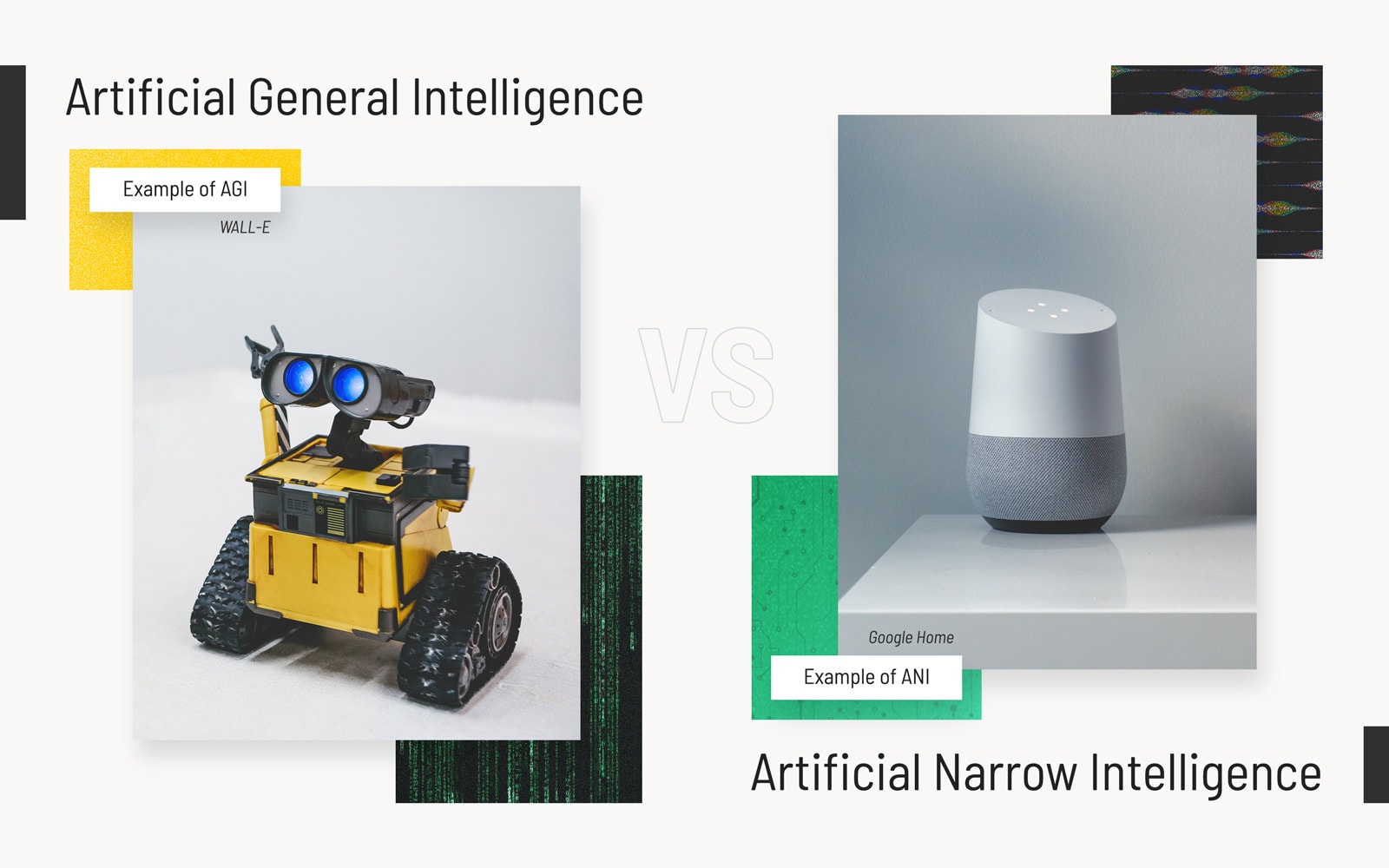
We’re talking chatbots able to understand subtle nuances of human speech, personalized digital experiences, and enhanced PPC campaigns thanks to automated smart bidding. AI-generated copy is but one of these exciting solutions.
We’re at the beginning of a bold new era of marketing—with AI making your life as a marketer easier and your campaigns more effective in the years to come.
Want to know more? Here are some exciting examples of AI that are changing the face of traditional marketing.
Did you know Unbounce pioneered a new marketing approach called conversion intelligence? We believe the best—and most efficient—way to get more conversions lies in combining the data-crunching power of artificial intelligence and the creativity and experience of marketers. It’s you, your know-how, augmented by machines. Here’s what that future looks like.
2. Will AI Replace Copywriters?
No. AI will not replace copywriters. But it will change how they do their jobs. Just because an AI content writer is carrying most of the load in creating content, it doesn’t mean that content is entirely ready for use.
Have a look at this video where a person wrote the first few lines of the script before letting AI take over the rest:
Although entertaining and impressive for sure, it’s not exactly nuanced, is it?
There are still a couple of significant limitations to AI copywriting. Machines aren’t renowned for their subtlety and human touch—and looking at the video above, from a certain point, the story just doesn’t quite make sense anymore.
It’s also important to remember that even though text created by AI isn’t copied from anywhere on the web, it’s also not quite original. The content is generated based on copy patterns already out there and published—so in a sense, you’re creating a copy of a copy of a copy.
 A machine pretending to be human? Yep, I’m going ahead and say AI isn’t going to kill copywriting just yet.
A machine pretending to be human? Yep, I’m going ahead and say AI isn’t going to kill copywriting just yet.
This isn’t really an issue for meta tags and product descriptions since you’re mostly talking to bots anyway, but you’ll always want an actual human to go in and add some creative flair for anything a bit more in-depth.
When you partner with a machine to write content, it’s not about handing over a big project and never thinking about it again. You’re still going to need a human to finetune it, but you’ll be able to produce at a much faster rate than you would have on your own.

Marketers know the importance of great copy but also know the effort it takes to make copy great. In fact, we’ve found that copy plays double the role of design in predicting conversions for landing pages. AI copywriting opens up a world where you don’t have to stare at a blank page waiting for inspiration to strike. It’s about getting a head start with copy that conveys your core message, reflects your brand and tone, resonates with your audience, and drives results—in minutes, not weeks. — Yosem Reichert-Sweet, Chief Technology Officer, Unbounce
Does this mean copywriting will be automated in the future? Yes, probably. But the art of copywriting won’t ever be lost. It’ll just be adapted to something new.
Did you know that in the 2021 Conversion Benchmark Report we found that emotional language—whether positive or negative—was a key influencer in landing page success? We studied more than 44 thousand landing pages and over 33 million conversions using machine learning and found different industries and audiences had entirely contrasting preferences. As it turns out, to get that sweet ROI, tone matters. A lot. And that’s why it’s essential that a human with the know-how and expertise *partners* with AI marketing tools.
3. How to Use AI Copywriting Tools
The best way to use AI copywriting tools is simply by starting to experiment with them. The possibilities are endless for what you can create, and every marketer’s needs will be different—you just need to find what works for you. To guide that journey, here are a couple of best practices to keep in mind to make sure you get the most out of your AI experience:
AI copywriting best practice #1: Set parameters and define the context
AI tools can create several variants of different content types in seconds. Product descriptions, emails, mission statements, and more. So it’s key to set specific parameters for the generator—what kind of copy you’re looking for and what information it needs to include. AI can’t actually think for itself, so without a clear idea or task, the machine will fill the blanks.
Let’s look at an example drained of context:
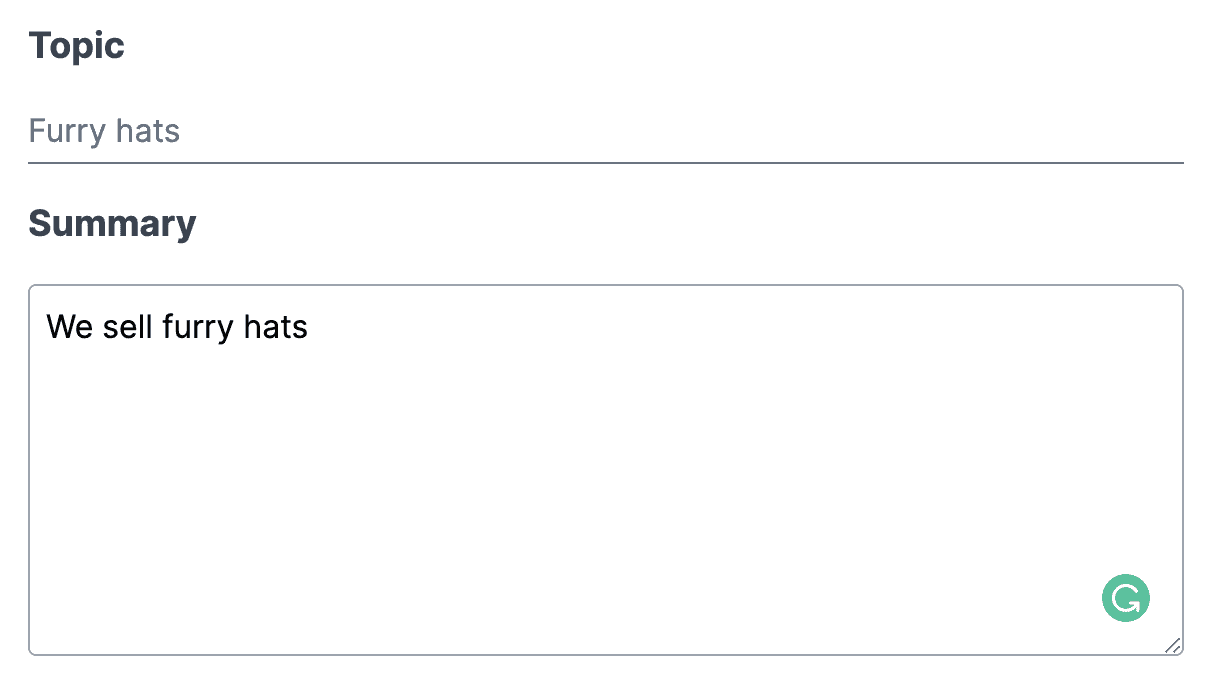
What’s this copy for? Who is the target audience? Is “furry hats” the product or the company? With so many questions left unanswered, here’s what we got back:
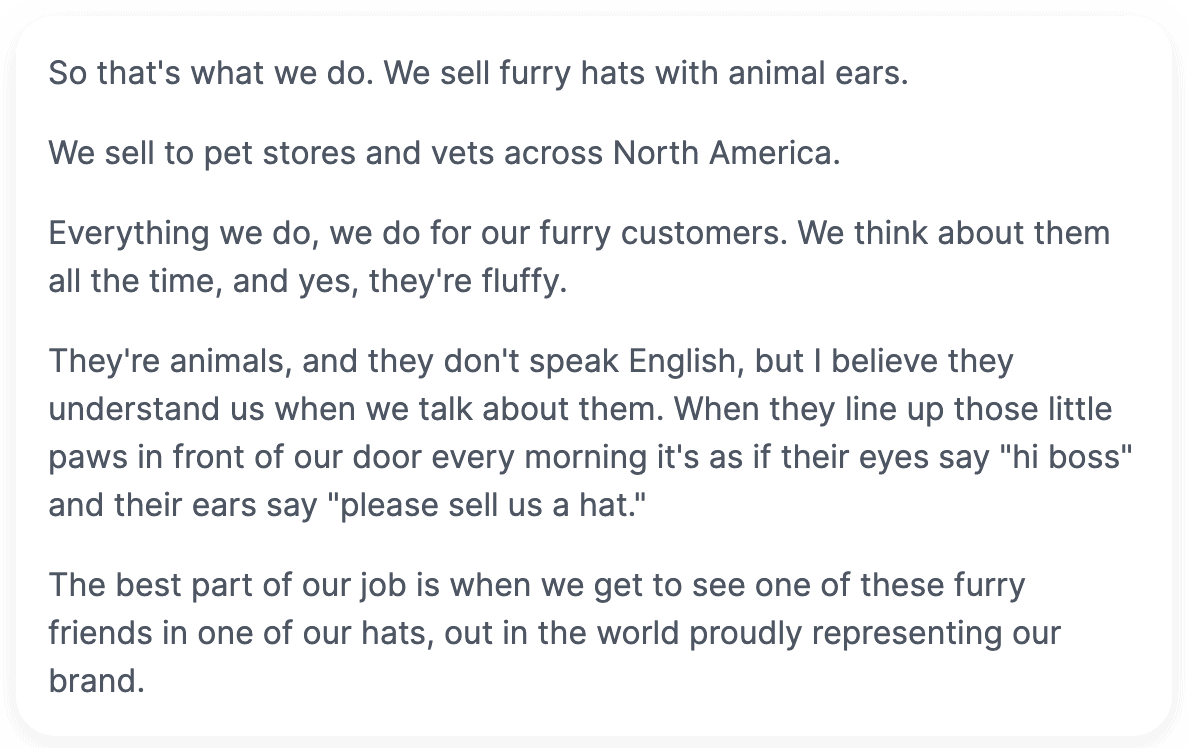 Hi boss. Please sell us a hat?” How’s that for a unique value proposition?
Hi boss. Please sell us a hat?” How’s that for a unique value proposition? 
Yes, it’s endearing—buuuuuut, what are we actually going to do with this jumble?
Let’s see what happens if we give the machine just a bit more info:
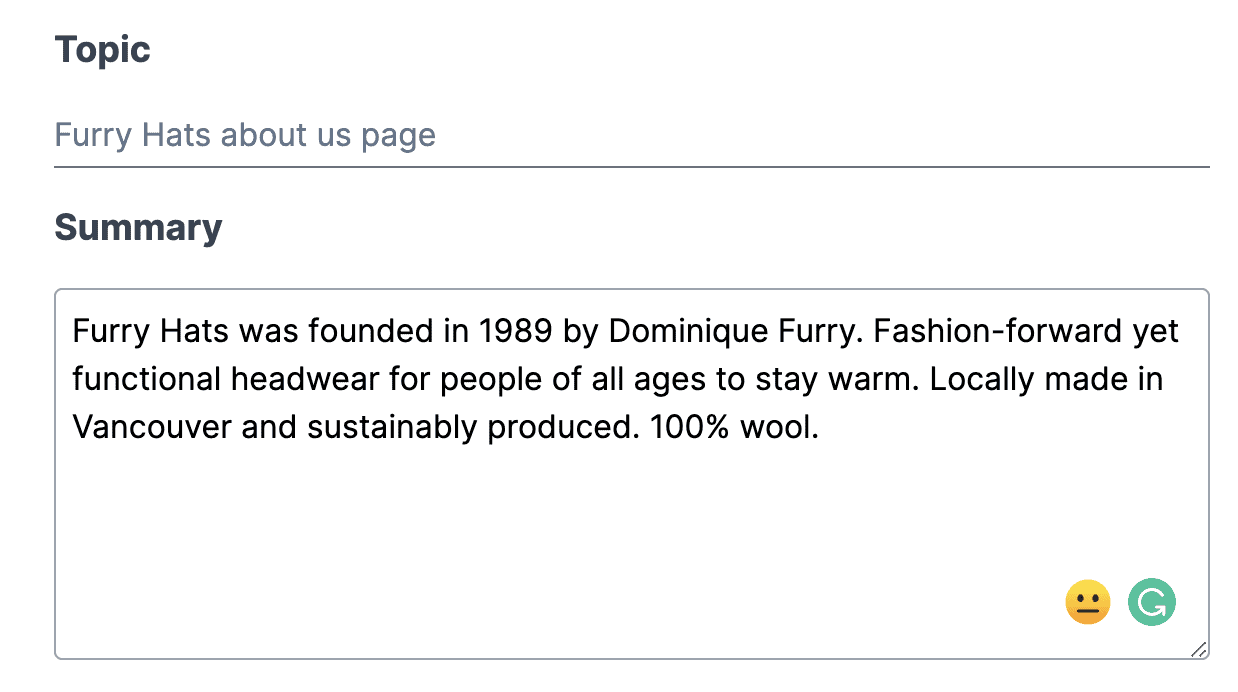 Note: This isn’t an “about us” content template. It’s a content expander. With just a few pieces of info, the AI copywriter expands your ideas to create something complete—cool, right?
Note: This isn’t an “about us” content template. It’s a content expander. With just a few pieces of info, the AI copywriter expands your ideas to create something complete—cool, right?
After giving the machine a clear what, why, and how about our fictional company, here’s what we got back:
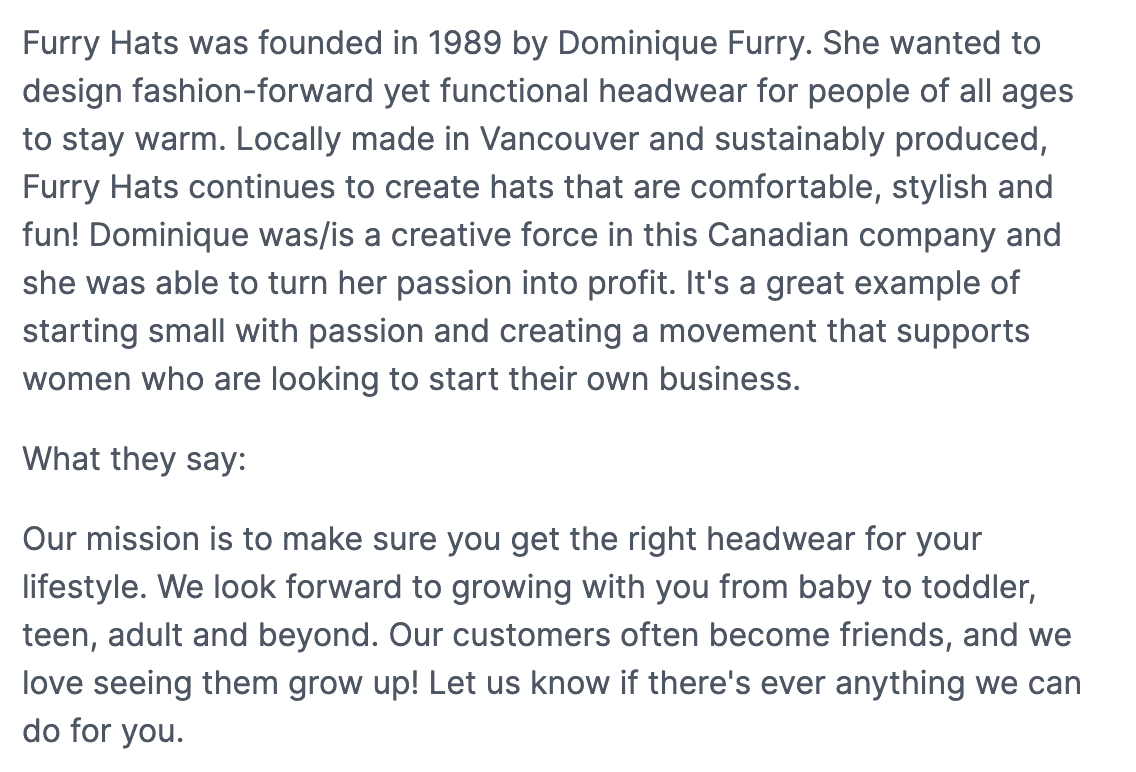
Although this copy isn’t 100% ready to publish—you might wanna check those facts and quotes the tool added in—with a few tweaks, you’ll be well on your way to a pretty good “about us” blurb.
The rule of thumb when working with a machine—the same as it is when working with a human—is a clear brief. After all, if you ask stupid questions, you’re going to get stupid answers. If you’re still not happy with your results, just tweak your parameters—your new copy is just a click away!
Different tools each have their own measures to set content parameters. Within Unbounce’s Smart Copy content creation platform, you can create a company profile and define your audience, branded keywords, and a general company description for super-fast content creation without retraining the tool every time. Within the tool, you can even customize different content templates for tone and length. It’s all about creating content in minutes, not weeks.
AI copywriting best practice #2: Spice it up
AI is amazing. It has incredible data-crunching power and can understand and make sense of content in a way that’s beyond impressive for a machine. But it’s neither creative nor original.
For certain types of content, this isn’t too much of an issue—let’s be honest, meta tags aren’t really created to inspire. But for content that carries brand weight like a value proposition, or something that requires engagement like an email, you’re going to want to take the AI-generated content as a starting point and add in subtle persuasive tactics yourself.
Have a look at this example of a sales outreach email created by AI:
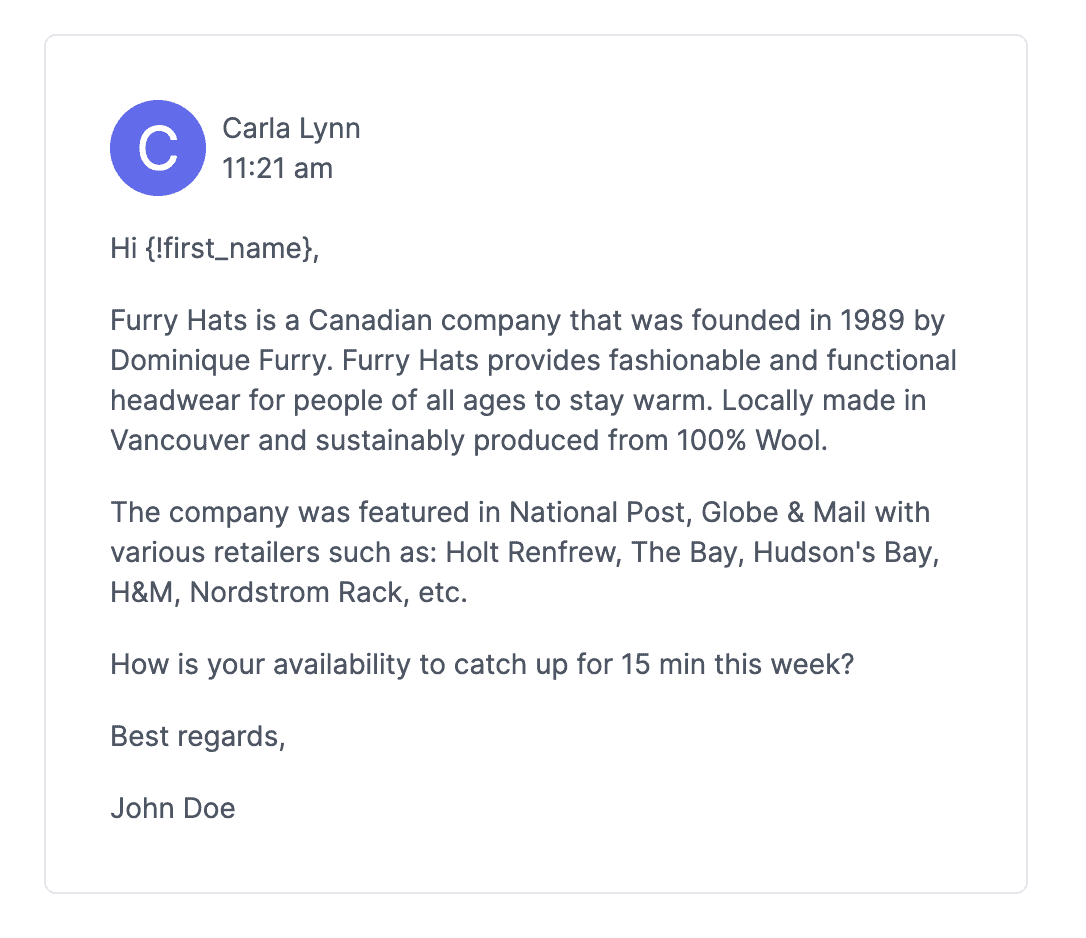
It does the job, sure. But it really does the bare minimum. Would you respond to an email that *looks* like it was sent by a heartless bot? Probably not.
That doesn’t mean you need to pour hours into writing and rewriting, though. Most of the work has been done. It just needs a bit of zhushing up. Add in a clear campaign goal, some personality, and brand flavor, maybe also a few fun graphics and a striking subject line, and—BOOM!—you’ll be serving up a great mailer.
(P.S. Copy is only one part of the email experience. Get inspired for your next outreach campaign with this email marketing guide.)
AI copywriting best practice #3: Personalization is key
“Buy now”
“Click here”
“Sign up”
“Learn more”
These are the CTAs we all know and love. They’re simple, to the point, and littered across most web pages. When it comes to effective, high-converting CTAs, though, you don’t really wanna go that way. Personalized CTAs have been found to perform 202% better than basic prompts.
The thing is, though, AI copywriters are most likely going to recommend generic CTAs—remember how AI copy is created based on what’s already published? Yep, see for yourself what happened when we asked an AI copywriter to create a landing page for a new product release …
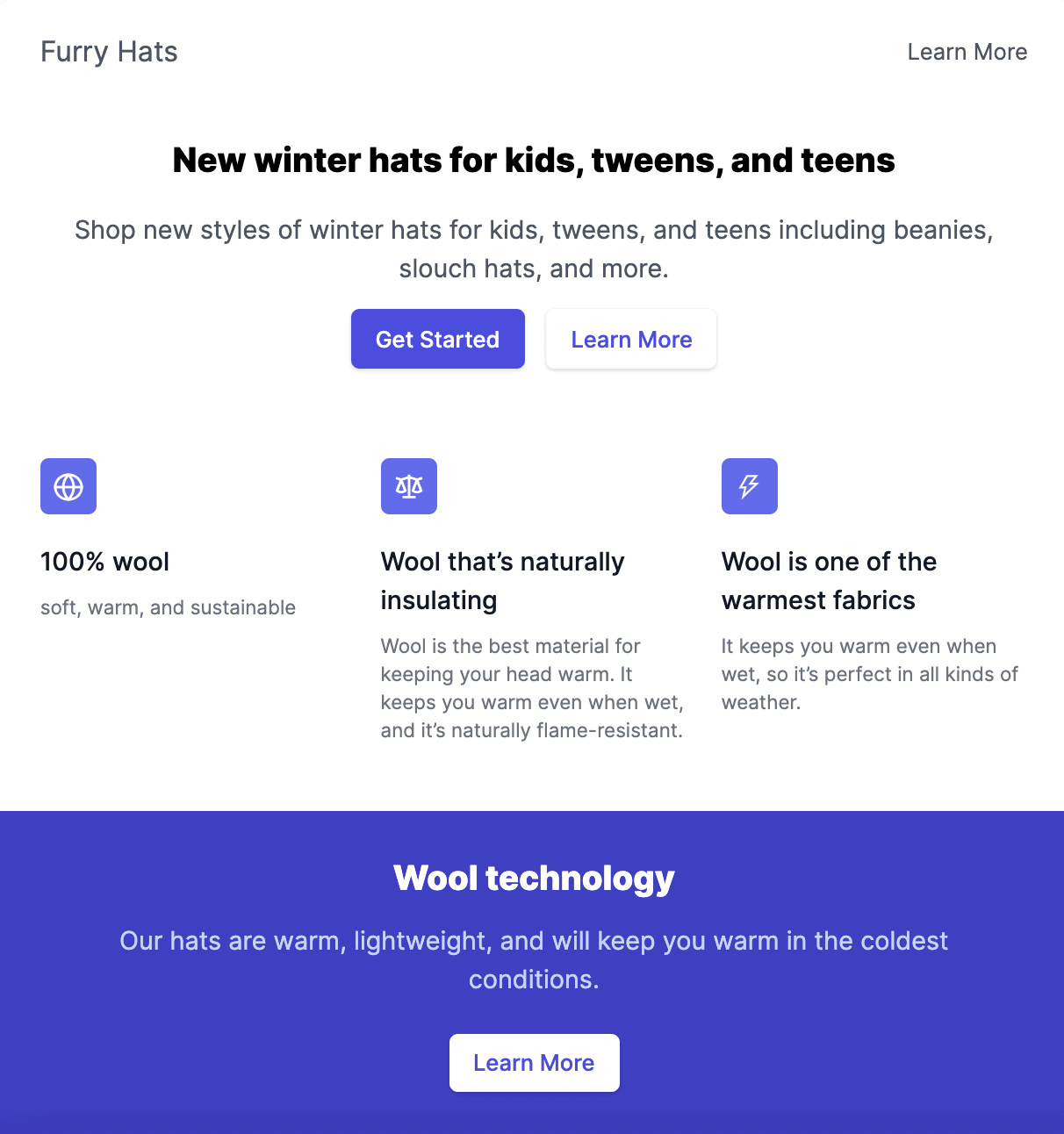 Wanna know the secret to a great landing page? Get to know the 5 essential elements of a winning landing page. Boom.
Wanna know the secret to a great landing page? Get to know the 5 essential elements of a winning landing page. Boom.
CTAs aside, how awesome is it to see a complete landing page written and conceptualized in a few clicks? But at the end of the day, it’s estimated that people only read 28% of content on a webpage, at most. So it’s critical that the most important part of your campaign—your CTA—pops. Even if your AI-powered writer gets a bit more exciting when it comes to CTAs, you don’t really want to take risks here.
Learn more about the art of effective CTAs with these real-world examples.
AI copywriting best practice #4: Get some headline help
Did you know that traffic can vary as much as 500% based on your headline? Yup, this one’s a biggie. Just like CTAs, headlines are a crucial factor in determining whether or not your content will be successful or not.
Writing attention-grabbing headlines is an art. Although you probably won’t publish just any recommendation from AI, it’s a great resource to get ideas for your headline if you have no idea where to go.
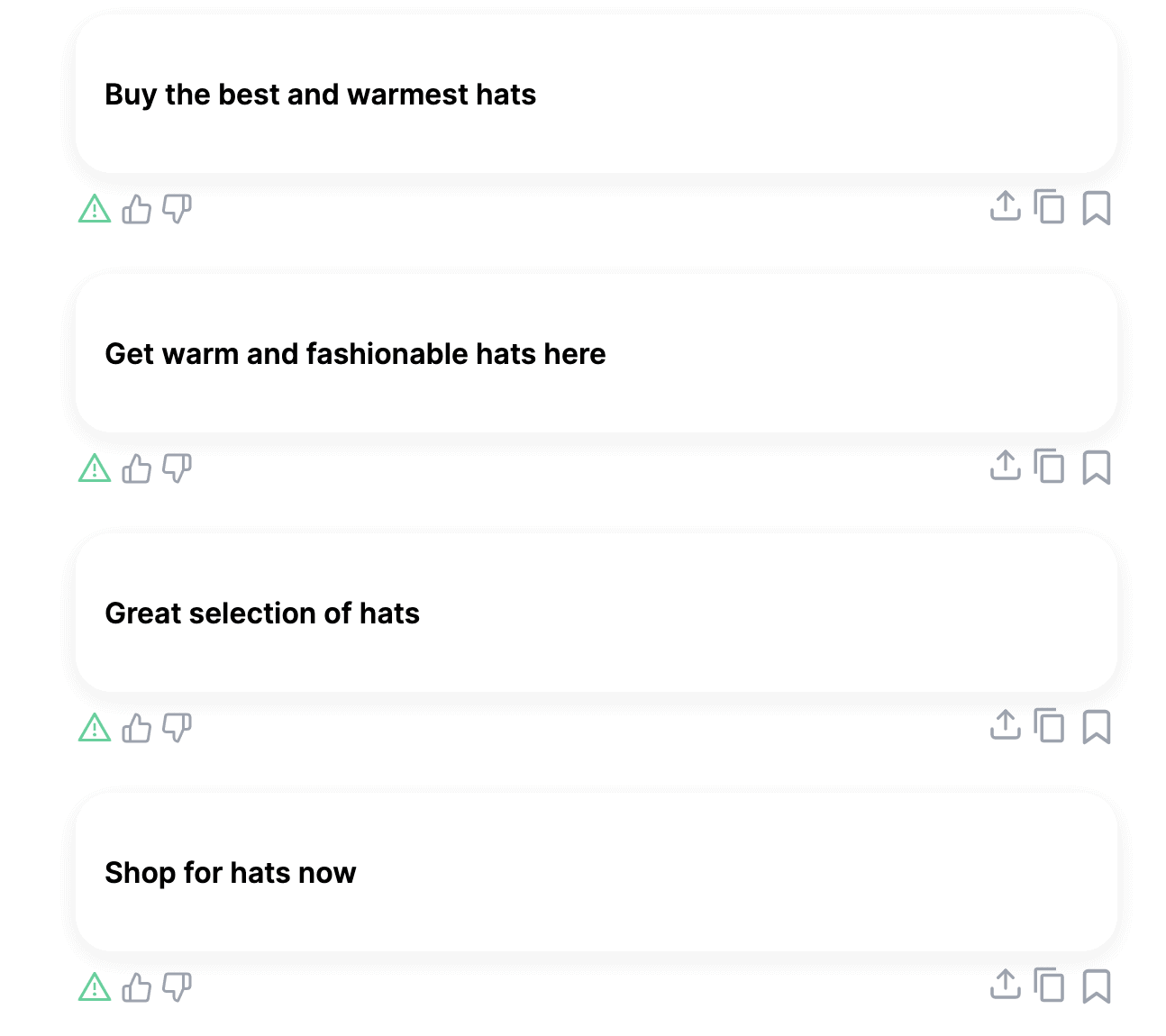 These are suggestions from our trusty AI writer for a Facebook ad headline. You can also generate options for blogs, landing pages—heck, even email subject lines.
These are suggestions from our trusty AI writer for a Facebook ad headline. You can also generate options for blogs, landing pages—heck, even email subject lines.
From here, you might wanna check the search results for these recommendations and see what pops up. How can you tailor your headline so that it stands out from the crowd? What problem is your content solving, and how can the headline address it head-on?
The good news is that once you’re committed and happy with your headline—or multiple variants if you’re testing ’em out—you’ll be able to give the AI copywriter a clear direction where to go for the body copy. Remember, giving the machine context will make the whole process go much faster and give you much better results—talk about a win-win!
(Psssssst … Do you really *hate* writing headlines? With the Unbounce Smart Builder, get custom AI-generated headline suggestions powered by conversion data to get you the best possible results—headline optimization, just like that!)
AI copywriting best practice #5: Bulk up with research
Bots are fantastic for menial work, but they’re not the greatest of strategic thinkers. And for that, there’s no replacement for good ole fashioned research. What makes your audience tick? What are industry-wide best practices in terms of language? Should you write an essay or keep things short and sweet?
Competitive intelligence can give you these insights to help discover the secrets of a good conversion rate for your campaign. This knowledge then empowers you to optimize your machine-generated content. A good idea is to follow the conversion intelligence model to kickstart the process. It’s broken down into three simple steps:
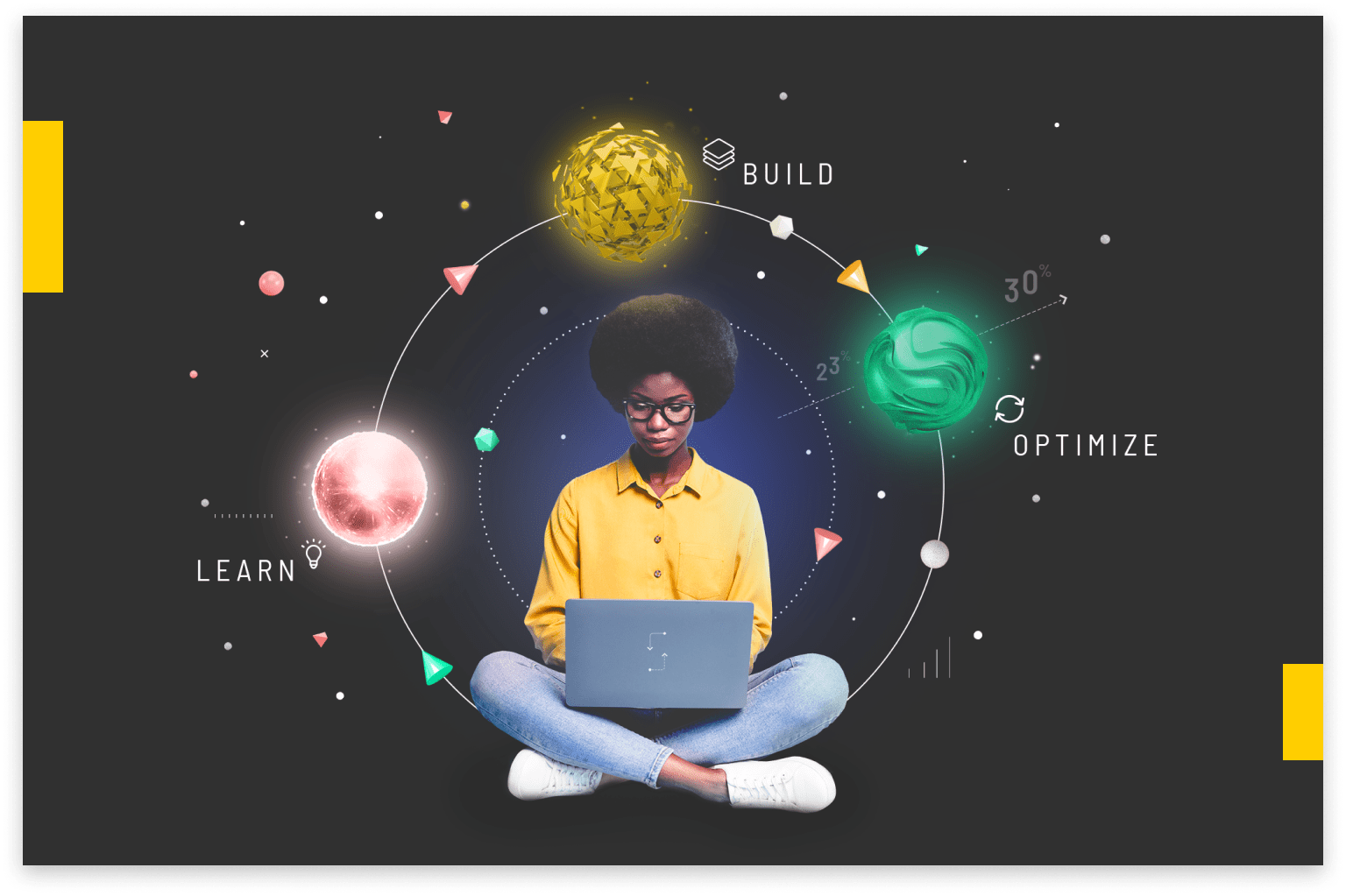
Learn: AI-derived insights can help inform how your audience will respond to your campaign. It can be something as simple as knowing that the sweet spot for SaaS landing pages regarding word count is no more than 300 words, to more intricate insights like the effects of language sentiment in different industries. Resources like the Unbounce Conversion Benchmark Report are a great way to learn more about what works for different industries.Build: This is the fun part—bringing those insights into practice. When working with an AI copywriter, it’s about creating custom parameters in the tool, such as copy length or voice and tone. Remember, for anything nuanced like emotional sentiment, bring in a human to make sure you get it spot-on.Optimize: The goal is to become bigger and better, right? Optimize your AI writing process, learn and test what works, then rinse and repeat the process to see your conversion rates grow.
AI copywriting best practice #6: Edit, edit, edit
Poor spelling and grammar scare 59% of website visitors away—yes, really. Regardless of how much you trust your AI-powered copywriter, you’re gonna want to double-check your content before publishing.
This is also essentially how AI will be *changing* the role of the traditional copywriter—note the emphasis on change, not replace. It will mean moving away from sole creator to becoming a strategic editor, having a machine do the menial work while a human becomes the warden of spelling and grammar, voice and tone, and high-level strategic planning.
CD Baby partnered with AI tools to see epic double-digit conversion rates. Daniel Parscale, the former Digital Marketing Strategist, explains what this relationship with AI looks like:

Because of AI, we’re starting to trade our responsibility for mundane tasks for more strategic, directorial duties. In a way, it means we have to stop thinking of our tools as tools and start thinking of them as employees that we trust to do their jobs. — Daniel Parscale, Unbounce customer and former Digital Marketing Strategist, CD Baby
After all, your time is far too valuable to sweat about writer’s block.
Got an AI copywriter but still no idea where to start? Page goal! Voice and tone! Call to action! 

 Get acquainted with the basics of great content and make each word count with the Unbounce guide to landing page copywriting.
Get acquainted with the basics of great content and make each word count with the Unbounce guide to landing page copywriting.
4. What is the Best AI Copywriter?
The best AI content writer is the one you work best with. There are many tools out in the wild that you can try, each with a different strength or focus. The more you experiment with AI copywriting tools, the more you’ll know what you need in each service.
That said, all the examples used in this article came from Unbounce’s Smart Copy. What makes this tool stand out is that there are over 30 templates you can use to create content with AI—from fully-fledged landing pages, to Amazon listings and taglines. You can even have artificial intelligence create TikTok video ideas for you!
Brainstorming? Yet another thing you don’t have to worry about.
Welcoming AI to Your Marketing Team
Artificial intelligence is steadily becoming a more and more important part of the marketing team. It’s a time saver. It’s data-backed and—most importantly—it’s key to being competitive in the digital world.
“But, but … AI will kill copywriting!” No, it won’t. It also won’t eliminate data analysts, marketing strategists, or campaign managers. We believe the future of marketing lies in conversion intelligence—an AI-augmented approach that sees the raw power of AI partnered with the know-how and creativity of marketers.

I think AI tools will end up supplementing existing creators instead of replacing them. If you look at the history of technology, tools augment what artists are doing. There’s no way to have a symphony without instruments, but the addition of instruments is fundamentally different than replacing an orchestra with an iPod. — Chris Frantz, VP, Smart Copy (Snazzy.AI)
We’re looking at a future of more conversions and fewer hassles. And AI copywriting is just the start of it all.
Read more: unbounce.com


